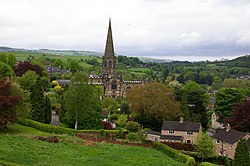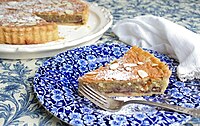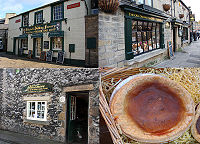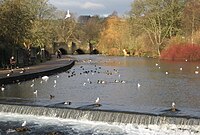Bakewell
| Bakewell | |
| Derbyshire | |
|---|---|
 All Saints' Church, Bakewell | |
| Location | |
| Grid reference: | SK2168 |
| Location: | 53°12’47"N, 1°40’41"W |
| Data | |
| Population: | 3,979 (2001) |
| Post town: | Bakewell |
| Postcode: | DE45 |
| Dialling code: | 01629 |
| Local Government | |
| Council: | Derbyshire Dales |
| Parliamentary constituency: |
Derbyshire Dales |
Bakewell is a small market town in the hills of Derbyshire. It is the only town included in the Peak District National Park, and is most famous for its local confections, the Bakewell tart and Bakewell pudding.
Bakewell is on the River Wye, about 30 miles north of the county town, Derby, and thirteen miles southwest of Sheffield. Its fellow Peak Distruict town, Buxton, stands to the west.
The town is close to two particular tourist attractions; Chatsworth House and Haddon Hall.
The name of the town is Old English, meaning 'Beadeca's Well'.[1]
History
Although there is evidence of earlier settlements in the area, Bakewell itself was probably founded in Anglo Saxon times. Bakewell's Parish Church was founded in 920 and today's later edifice has a 9th-century cross in the churchyard. By Norman times Bakewell had gained some importance—the town and its church (having two priests) being mentioned in the Domesday Book.
The present church was constructed in the 12th and 13th centuries but was virtually rebuilt in the 1840s by William Flockton.[2]
A market was established in 1254, and Bakewell developed as a trading centre. The Grade I listed five-arched bridge over the River Wye at Bakewell was constructed in the 13th century, and is one of the few surviving remnants of this earlier period.[3]
A chalybeate spring was discovered, and a bath house built in 1697. This led to an 18th-century bid to develop Bakewell as a spa town, in the manner of Buxton. The construction of the Lumford Mill by Richard Arkwright in 1777 was followed by the rebuilding of much of the town in the 19th century.
Economy
Bakewell attracts many domestic and international tourists. Monday is popular with visitors as the traditional market is held in the town on this day. The cattle market is housed in a new purpose built agricultural centre, across the river from the main part of the town. A medium-sized stall market is held in the town centre. There is a picturesque public park, alongside the River Wye, which has its source in nearby Buxton (illus. below). For a town of its size, it has a very large town centre. This is mainly because of the tourist nature of the town.
A major employer within the town is the Peak District National Park Authority, based at Aldern House on the Baslow Road. The National Park Authority is tasked with conserving and enhancing, as well as promoting understanding and enjoyment, of the local area.[4] Opposite Aldern House is another major employer, Newholme Hospital], an NHS cottage hospital providing outpatient clinic services to the local community.
A campaign in the town, involving local tradespeople, has sought to prevent the establishment of a branch of Costa Coffee in the town.[5]
Parish church

All Saints Church is a Grade I listed church, built in the 12th and 13th centuriesm, and heavily restored in the Victorian period. A church was founded here in 920, and the churchyard has two 9th-century Saxon crosses. During the restoration work, in the 1840s, many carved fragments of Saxon stonework were found in and around the porch, as well as some ancient stone coffins.
One cross is the Beeley Cross, dug up in a field at a disputed location near Beeley and moved for some years to the grounds of Holt House near Darley Bridge. Although only the base and lower part of the shaft survive, it stands over five feet high and is carved on all four faces.[6]
The other cross is the Bakewell Cross, eight feet high and almost complete. It was carved in the 7th or 8th century and shows a number of scenes including one of the Annunciation. This cross may originally have stood at Hassop Cross Roads, although there is no firm evidence for this.[6]
The church contains a selection of cross fragments and carved stones collected by Thomas Bateman and donated to Weston Park Museum in Sheffield before being moved to Bakewell in 1899.[6]
Railway
In 1862, the Manchester, Buxton, Matlock and Midlands Junction Railway opened Bakewell railway station. The line became part of the Midland Railway and later the LMS main line from London to Manchester. John Ruskin objected to what he saw as the desecration of the Derbyshire countryside, all so that "a Buxton fool may be able to find himself in Bakewell in twelve minutes, and vice versa." In return for the Duke of Rutland's permission for the line to pass through his estate at Haddon Hall, the Bakewell station buildings, located on the hillside overlooking the town, are more imposing than a small town might be thought to justify, and the Duke's coat of arms are carved into the stonework. It is said that the inconvenient high contour of the railway, which forced the station to be placed out of town, was due to the Duke insisting that the line ran out of sight of Haddon Hall. The station buildings are now used for small businesses, because the line between Matlock and Buxton closed in 1968: most of the trackway has now been designated the Monsal Trail, a quiet motor-traffic-free track for walking, cycling, and horseriding.
"Normal" trains now run from Derby via Ambergate only as far as Matlock, and from Manchester only as far as Buxton. There have been repeated proposals for fully reopening the remaining, Wye Valley, portion of the line, which would run through Bakewell and over the magnificent Monsal Dale viaduct.
Peak Rail, a local preserved railway venture, has shown the way by reopening the line from Matlock to Rowsley, a village a few miles to the east of Bakewell near Haddon Hall. Reaching Bakewell is just one of Peak Rail's long-term ambitions, and in order to keep alive the intention for a future return of the railway (under one auspice or another), Derbyshire County Council is currently protecting the trackbed from development, (in order of seeing the old railway station fully restored and return to its former glory and use, as it still remains completely intact).
Tarts and puddings
The Bakewell tart and Bakewell pudding are two different but related confections originating in Bakwell, both delicious and bringing rightful fame to the town.
Bakewell pudding

Bakewell pudding is a jam pastry with an egg and ground almond enriched filling. The origins of the pudding are not clear; however, the generally accepted story is that it was first made by accident in 1820 when the landlady of the White Horse Inn (now called the Rutland Arms) left instructions for her cook to make a jam tart with an egg and almond paste pastry base. The cook, instead of stirring the eggs and almond paste mixture into the pastry, spread it on top of the jam.[7] When cooked the jam rose through the paste. The result was successful enough for it to become a popular dish at the Inn.
The authoress Allison Uttley, who lived in Lea, a village near Bakewell, wrote in her book Recipes from an old Farmhouse under the heading Bakewell Tart:
"(The local name was Bakewell Pudding, for the tart was really for the pudding stage of a meal and not for tea)
Cover a wide shallow dish with thin puff paste. Put in it a layer of jam, preferably raspberry, but any kind will do. It should be half an inch thick. Take the yolks of eight eggs and beat the whites of two. Add half a pound of melted butter and half a pound each of sugar and ground bitter almonds. Mix all well together, and pour into the pastry case over the jam. Bake for half an hour and serve nearly cold.
This was one our favourite dishes, but it was a rich dish for special occasions only."
Bakewell tart


A Bakewell tart is one particular version of the Bakewell pudding, made with a shortcrust base. It consists of a sponge mixture in a pastry case, flavoured with almonds, with jam at the bottom.
Three shops in Bakewell offer what they each claim is the original recipe. The Bakewell Tart Shop & Coffee House sells four different variations of the confection, including: "Bakewell Tart", "Iced Bakewell Tart", "Moist Bakewell Tart" and "Traditional Bakewell Pudding";[8] whilst The Old Original Bakewell Pudding Shop and Bloomers of Bakewell both sell a "Bakewell Pudding".[9][10]
Commercial versions often bear little relation to the true Bakewell tart either in flavour or texture, typically taking the form of an cupcake with almond essence to flavour, then iced so thickly as to hide the flavour.
Events
Annual events in the town include:
- "Well dressing", a Peak District tradition, takes place during June in which colourful images made of petals embedded into clay appear at several places throughout the town.
- Bakewell Agricultural Show (the Little Royal), one of the largest covered agricultural show in Britain.[11] It takes place on the first Wednesday and Thursday in August at the Bakewell Showground.
- Bakewell Arts Festival in August
- The Peak Literary Festival is held in the Spring and Autumn of each year. The Spring festival starts on the last Friday in May and the autumn on the last Friday in October.
- Carnival week, culminating in a procession through the town, held at the beginning of July.[12]
Sport and recreation
- Football:
- Bakewell Red Lion FC
- Bakewell Town FC
- Rugby union: Bakewell Mannerians RUFC
Bakewell has a large recreation park to the east of the town centre, which has tennis courts, children's playground, and football/cricket pitches. In the town itself, and located near to the library, is the municipal swimming pool and gym.
In literature
Bakewell is mentioned by Elizabeth Bennet as the town from which she travelled to visit Pemberley, in ch. 43 of Jane Austen's Pride and Prejudice.
On television
- In 2010 the Rutland Arms Hotel featured in an episode of "The Hotel Inspector".[13]

Outside links
| ("Wikimedia Commons" has material about Bakewell) |
- Bakewell Parish Church
- BakewellOnline.co.uk
- Bakewell.co.uk - Bakewell community site
- Peak District: Bakewell
- BakewellDerbyshire.com
- CressBrook Towns: Bakewell
References
- ↑ Roy Millward & Henry Wardle Robinson, The Peak District (Eyre Methuen, 1975)
- ↑ National Heritage List 13103941: Church of All Saints, Bakewell
- ↑ National Heritage List 1148112: Bridge, Bakewell
- ↑ "The work of the Authority - Peak District National Park Authority". Peak District. Archived from the original on 29 October 2009. http://web.archive.org/web/20091029143023/http://www.peakdistrict.gov.uk/index/looking-after/npa.htm. Retrieved 17 October 2009.
- ↑ "Bakewell unites around tarts to fight off Costa Coffee", Alexandra Topping in The Guardian, 1 February 2013
- ↑ 6.0 6.1 6.2 Neville T. Sharpe, Crosses of the Peak District (Landmark Collectors Library, 2002)
- ↑ Rutland Arms Hotel Bakewell
- ↑ Bakewell Tart Shop
- ↑ The Old Original Pudding Company Limited
- ↑ Bloomers Original Bakewell Pudding
- ↑ show.org Bakewell Show
- ↑ Discover Derbyshire and the Peak District
- ↑ "Five TV". Five TV. http://www.five.tv/programmes/lifestyle/the-hotel-inspector/86368.
Books
- Town Without Pity, Don Hale, Century (4 April 2002), ISBN 0-7126-1530-X
- Bakewell: The Ancient Capital of the Peak, Trevor Brighton, Devon Books (Nov 2005), ISBN 1-84114-419-3
- Bakewell, Robert Innes-Smith, Derbyshire Countryside Ltd; 2r.e. edition (Jan 1994), ISBN 0-85100-114-9
- Events In Bakewell
- Bakewell in the Domesday Book
